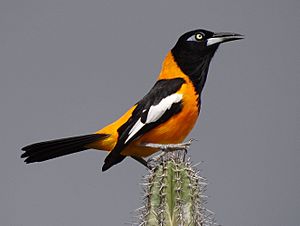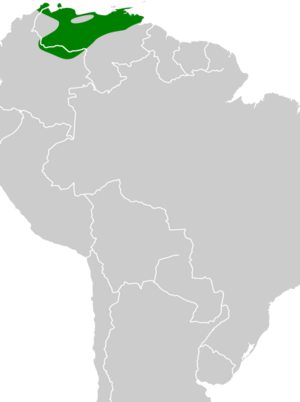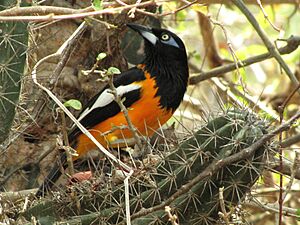Venezuelan troupial facts for kids
Quick facts for kids Venezuelan troupial |
|
|---|---|
 |
|
| Conservation status | |
| Scientific classification | |
 |
|
| Synonyms | |
|
Oriolus icterus Linnaeus, 1766 |
The Venezuelan troupial (Icterus icterus) is a beautiful bird and the national bird of Venezuela. You can find it in countries like Colombia and Venezuela, and on Caribbean islands such as Aruba, Curaçao, Bonaire, Trinidad, and Puerto Rico. This bird is known for its bright colors and interesting habits.
Contents
What's in a Name?
The name troupial comes from a French word meaning "troop." This is because these birds often live together in groups or flocks. The scientific name icterus comes from an old Greek word for "yellow bird." This makes sense because the troupial has a lot of bright yellow-orange feathers!
What Does the Troupial Look Like?
Venezuelan troupials are fairly large birds with a long tail. They have a strong, thick beak. Their head and the top part of their chest are black. The feathers on their neck and upper chest stick out a bit, creating a cool, uneven line between the black and the bright orange parts of their body.
The rest of their body, including their lower chest and belly, is a vibrant orange. This orange color also covers their upper and lower back. Their shoulders are black, separating the orange on their back. Their wings are mostly black, but they have a clear white stripe that runs along the length of the wing when it's folded. Troupials have yellow eyes, and around each eye, there's a patch of bright blue skin without feathers.
Different Types of Troupials
There are three slightly different kinds, or subspecies, of the Venezuelan troupial:
- I. i. icterus
- I. i. ridgwayi
- I. i. metai
The I. i. metae troupials have more orange on their backs. They also have a black line that divides the white stripe on their wing in half. The I. i. ridgwayi troupials are generally bigger and stronger than the other types.
Where Do Troupials Live?

Venezuelan troupials like to live in dry places. These include woodlands, areas with lots of trees near rivers (called gallery forests), dry scrublands, and open grasslands. They often look for food in places with large cacti.
Their main food source, especially when in season, is the fruit of giant cacti. But they also enjoy other fruits like mangoes, papayas, and dates. Sometimes, they even eat young birds or unhatched eggs from other birds' nests!
Reproduction and Nesting Habits
Venezuelan troupials usually breed from March to September. They are quite unique because they don't build their own nests. Instead, they are "nest pirates"! This means they either find an empty nest or they take over an active nest from other birds.
Troupials can be very aggressive when taking over a nest. They might even eat any eggs or young birds that are already in the nest they've taken. Once they have a nest, they will fiercely protect it from other birds. After settling in, the adult troupials will lay their own clutch of three to four eggs. These eggs usually hatch after about two weeks.
Troupial Behavior
Both male and female troupials show defensive behavior, especially when it comes to mating. Male troupials often sing to attract females or to warn off other competing troupials. They also sing together in duets to protect their territory and to communicate with each other. This singing behavior helps them stay in touch, whether they are breeding or not. Troupials that have a partner tend to be more vocal and physically protective of their territory.
Troupials in Culture
The Venezuelan troupial is a very important symbol in Venezuela. As the national bird, it has even appeared on the back of the Venezuelan Bs.S 500 banknote.
In 2015, former Miss International Edymar Martínez wore a special national costume featuring the image of the Venezuelan troupial at a competition in Tokyo, Japan.


